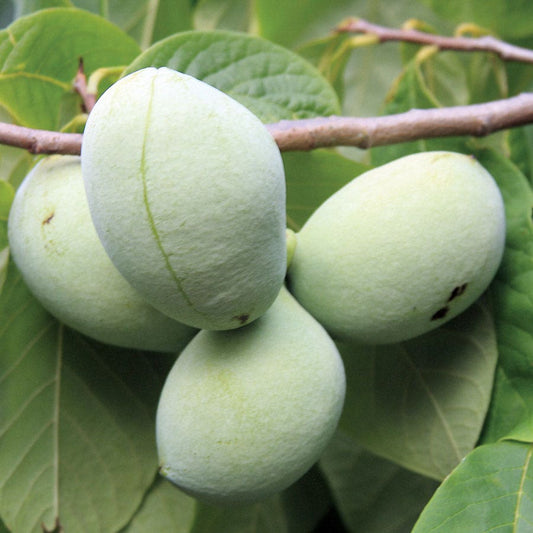Asimina / Paw Paw
Cultivate the tropical flavors of paw paw in your garden oasis. Learn about paw paw tree varieties, gain insights into tree care, and embrace the unique harvest tips for these delectable fruits.
-
Asimina 'Potomac' PawPaw
Regular price $56.95Regular priceUnit price per$56.95Sale price $56.95Sold out -
Asimina Paw Paw Shenandoah
Regular price $59.95Regular priceUnit price per$59.95Sale price $59.95Sold out -
Asimina 'Mango' Paw Paw
Regular price $62.95Regular priceUnit price per$62.95Sale price $62.95Sold out -
Asimina 'Susquehanna'® PawPaw
Regular price $62.95Regular priceUnit price per$62.95Sale price $62.95Sold out
Asimina / Paw Paw
The Asimina genus contains small fruiting trees and shrubs, commonly called paw paws. Asimina triloba (common pawpaw) is a widespread North American native species usually found growing wild in the understory of hardwood forests in the eastern regions of the U.S. Paw paws produce attractive purplish brown flowers in spring followed by sweet-tasting fruit in fall. They offer fall color, similar to ginkgo, and they are the only host plant of the zebra swallowtail butterfly. The fruits (also called paw paws) were a staple of the Native American diet and once grown at Monticello but are now considered America’s forgotten fruit. However, paw paws are having a revival, with a plethora of products hitting the market, including wines, beers, preserves, chutneys, and ice cream. But many believe paw paws are best eaten raw, likening the rich, custard-like texture and flavor to a tropical blend of banana, mango, and pineapple or to chilled vanilla pudding. At 2 to 5 inches long and weighing 5 to 7 ounces, paw paws are the largest U.S. native fruits (actually a berry). Green when unripe, they turn black as they ripen and acquire a strong fruity aroma. The fruit is very nutritious and high in antioxidants.
Asimina is a small genus of 11 or so species, with trees typically growing 15 to 20 feet tall with a similar width. Along with A. triloba, species include A. angustifolia (slimleaf pawpaw), A. incana (woolly pawpaw), A. obovate (bigflower pawpaw), A. parviflora (small-flowered pawpaw), and A. pygmea (dwarf pawpaw). Paw paws grow best in deep, fertile, consistently moist, well-draining soil, having a 5.5 to 7.0 pH, with best fruiting occurring in full sun. They are disease and deer resistant. Depending on cultivar, the trees may take 4 to 5 years to start producing fruit, but they're well worth the wait.




